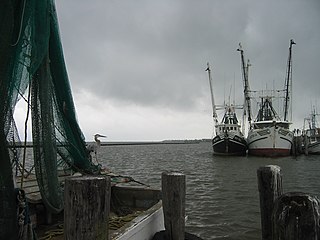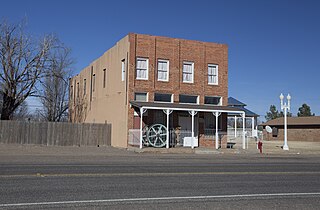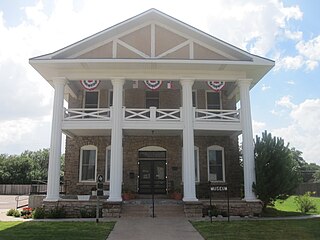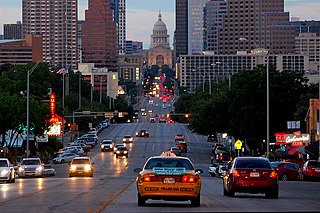Related Research Articles

Enos Bradsher Slaughter, nicknamed "Country", was an American Major League Baseball (MLB) right fielder. He played for 19 seasons on four major league teams from 1938–1942 and 1946–1959. He is noted primarily for his playing for the St. Louis Cardinals and is best known for scoring the winning run in Game 7 of the 1946 World Series. A ten-time All-Star, he has been elected to both the National Baseball Hall of Fame and St. Louis Cardinals Hall of Fame.

Slaughter Beach is a town in Sussex County, Delaware, United States. The population was 207 at the 2010 census, an increase of 4.5% over the past decade. It is part of the Salisbury, Maryland-Delaware Metropolitan Statistical Area.

Fulton is a town in Aransas County, Texas, United States. As of the 2010 census, this South Texas coastal fishing community had a population of 1,358. The town is named for George Ware Fulton, a land developer in the area.

Rockport is a city in Aransas County, Texas, United States. The population was 8,766 at the 2010 census. It is the county seat.

Morton is a city and county seat of Cochran County, Texas, United States. As of the 2010 census, the city population was 2,006. This represented a 10.8% population decline since the 2000 Census.

Whiteface is a town in Cochran County, Texas, United States. The population was 449 at the 2010 census.

Post is a city in and the county seat of Garza County, Texas, United States. The population was 5,376 at the 2010 census.
Texas is a state of the United States.

John Horton Slaughter, also known as Texas John Slaughter, was an American lawman, cowboy, poker player and rancher in the Southwestern United States during the late 19th and early 20th centuries. After serving in the Confederate States Army during the American Civil War, Slaughter earned a reputation fighting hostile Indians and Mexican and American outlaws in the Arizona and New Mexico territories. In the latter half of his life, he lived at the San Bernardino Ranch, which is today a well-preserved National Historic Landmark in Cochise County in far southeastern Arizona. In 1964, he was inducted into the Hall of Great Westerners of the National Cowboy & Western Heritage Museum.

Congress Avenue is a major thoroughfare in Austin, Texas. The street is a six-lane, tree lined avenue that cuts through the middle of the city from far south Austin and goes over Lady Bird Lake leading to the Texas State Capitol in the heart of Downtown.
Texas John Slaughter is a western television series which aired seventeen episodes between 1958 and 1961 as part of The Wonderful World of Disney, starring Tom Tryon in the title role. The character was based upon an actual historical figure, Texas Ranger John Horton Slaughter. Tryon memorably wore an enormous white cowboy hat with the brim pinned up in the front as part of his wardrobe for the series. Narration is provided by Paul Frees.

San Bernardino Ranch is an historic ranch house in the southern San Bernardino Valley near the San Bernardino National Wildlife Refuge in extreme southeast Cochise County, Arizona, United States. It is significant for its association with the beginning of cattle ranching in southern Arizona and northern Mexico. The ranchland and valley are part of the headwaters region of the Yaqui River.
The Sutton–Taylor feud began as a county law enforcement issue between relatives of a Texas state law agent, Creed Taylor, and a local law enforcement officer, William Sutton, in DeWitt County, Texas. The feud cost at least 35 lives and eventually included the outlaw John Wesley Hardin as one of its participants. It began in March 1868, not reaching its conclusion until the Texas Rangers put a stop to the fighting in December 1876.
Christopher Columbus Slaughter (1837–1919) was an American rancher, cattle drover and breeder, banker and philanthropist in the Old West. After serving in the Confederate States Army during the American Civil War of 1861-1865, he came to own 40,000 cattle and over one million acres of ranch land in West Texas. He became the largest taxpayer in Texas, and used his wealth to endow Baptist institutions. He was known as the "Cattle King of Texas."
Robert Lee Slaughter (1870-1938) was an American rancher and oilman. He was the owner of ranches in Texas, USA and Sonora, Mexico.
Vealmoor, Texas is a small town in Howard County, Texas, United States.
Coldwater is a ghost town in Sherman County, Texas. It was the county seat from 1889 to 1901.
William B. Slaughter (1852–1929) was an American rancher, cattle driver, banker and county judge. Born into a ranching family, he drove cattle and ranched in New Mexico before acquired a ranch in Sherman County, Texas. He founded local banks in Texas and New Mexico, and he was tried but acquitted on suspicion of faulty loans. He retired in San Antonio, Texas.
John Bunyan Slaughter (1848-1928) was an American rancher and banker. Born to a ranching family, Slaughter ranched in Texas and New Mexico before acquiring the U Lazy S Ranch in Garza County, Texas in 1901 and managing it for nearly three decades.
Michelle Slaughter is a Judge of the Texas Court of Criminal Appeals
References
- 1 2 3 4 Smith, Julia Cauble (June 15, 2010). "SLAUGHTER, TX". Handbook of Texas Online . Texas State Historical Association . Retrieved January 4, 2016.
 | This article about a location in Midland County, Texas is a stub. You can help Wikipedia by expanding it. |